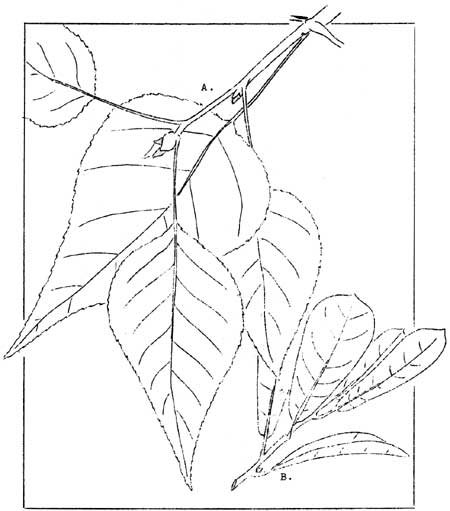BLACK COTTONWOOD.
(Populus trichocarpa)
This is the largest deciduous tree in the park and one that will be
commonly found in moist situations along streams and creek bottoms up to
about 4000 feet in elevation.
Mature specimens of good average size are from 50-100 feet
tall and 12-24 inches in diameter although larger trees
will occasionally be found. The trunks are straight and often
clear of limbs for a considerable part of their length. The bark,
on old trees over 12 inches in diameter, is dark ash-grey and deeply
furrowed, while on younger and smaller trees, as well as upon the
branches and upper portions of older trees, it is smooth and a light
grey in color. The branches are large and rather brittle. The
mature leaves are large, thick and leathery in texture; smooth,
shiny a yellow-green above, silvery white below and prominently veined.
In the fall, before dropping from the trees, they change to yellow and
later to a dull brown. They are broadly ovate in outline with coarsely
toothed margins, 3-6 inches long and 2-1/2 - 5 inches wide at the base,
with long stout petioles. The staminate and pistillate flowers are borne
in catkins on different trees. The fruit consists, of many tiny seeds
which are enclosed in globular green capsules until ripe. Each small
seed has a tuft of white hairs at the apex by which it is carried about
by the wind. The white tuft of hairs upon the seeds accounts for the
common name of "cottonwood". The wood is soft and grey to
brownish in color.
This tree is often cut by beaver and the bark used for food by this
interesting animal. The largest specimen so cut; measuring 36 inches in
diameter was noted several years ago along the Nisqually River.
The age of the black cottonwood is probably not great as it is
a rather fast growing, short-lived species. Trees 18-24 inches in
diameter are from 50-125 years old.
This species will be found from southern Alaska and the Yukon on the
north, south through British Columbia, Washington, Oregon and northern
California. It is also present in northern Idaho and western
Montana.
-oOo-

BLACK COTTONWOOD (Populus trichocarpa). A-Foliage
(x1).
SITKA WILLOW (Salix sitchensis). B-Foliage (x),
illustrating the spatulate outline of leaves.
-oOo-
Descriptions continued...

